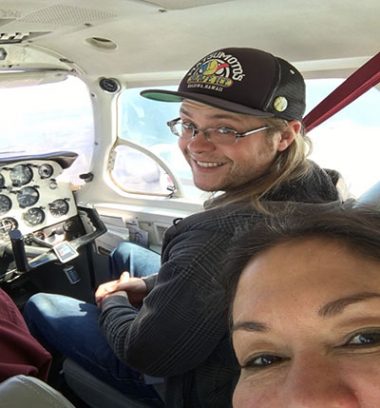
By Dustin Love, RCAC publications and graphic design specialist
I first saw the village of Kotlik from the window of a small bush plane after an hour’s flight from the “hub town” of Bethel, over the tundra of the Yukon-Kuskokwim Delta in southwest Alaska. My air travel began with an hour long 737 jet ride from Anchorage to Bethel. Kotlik is a small, Yupik community adjacent to the Kotlik River, which flows from the Yukon River. Kotlik faces many severe economic and infrastructure challenges. Like most villages, Kotlik is isolated due to the lack of road systems in rural Alaska.
I traveled to Kotlik with my colleague Jacqueline Shirley, Rural Community Assistance Corporation rural development specialist and a solid waste expert, who grew up in a similar nearby Yupik village, and Dr. Edda Mutter of the Yukon River Inter-Tribal Watershed Council. For the next three days, I would be filming an instructional video as Jacqueline and Edda taught the Tribe proper landfill assessment water sampling techniques.
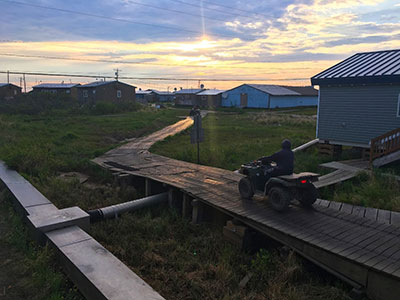
The community doesn’t have the funds to move the intake pump or the landfill. Our job was to conduct water sampling at the landfill and the drinking water intake pump to test for contaminants. Since Kotlik’s situation is somewhat common among villages in this region, we planned to create an instructional video so that other Tribes can conduct their own sampling. After landing on the short, gravel runway, we were escorted across Kotlik’s wooden boardwalk on an ATV (the mode of travel in rural villages) to the Tribal office where we met Victor, a kind, soft-spoken man who was our guide for the project. He carefully explained the landfill situation to us. The landfill is located a short distance upstream from the community, at the junction of the Yukon and Kotlik rivers. Community members have been self-hauling their trash, via boat, to the landfill for many years, which has caused the waste to spread out past the landfill boundaries. This, combined with rapid erosion and recent flooding events is washing trash into the river. Aside from obvious environmental impacts, this has caused public health concerns within the community because the drinking water intake pump is located a short distance downstream from the landfill and no one knows if it is impacting the drinking water source.
The community doesn’t have the funds to move the intake pump or the landfill. Our job was to conduct water sampling at the landfill and the drinking water intake pump to test for contaminants. Since Kotlik’s situation is somewhat common among villages in this region, we planned to create an instructional video so that other Tribes can conduct their own sampling.
After our meeting, Victor took us to the landfill in his boat. During the ride, we passed many similar boats and I realized how important the river is to the community as their home and source of water, food and transportation. As we were leaving the village, I noticed a couple houses that were falling into the river and Victor explained that a recent flood had caused severe erosion and damage to their infrastructure.
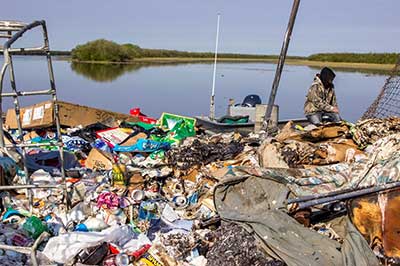
When we arrived at the landfill, I was shocked to see how close the trash was to the riverbank and realized the severity of the problem. Unlike communities in the U.S. with road systems, trash is not “out of sight, out of mind.” There are no trash collection services or transfer stations and each household manages their refuge from purchase to disposal. This is not the best solid waste management practice, so the Tribal government is trying to step in with their limited resources and capacity to improve the solid waste management conditions and circumstances for their community.
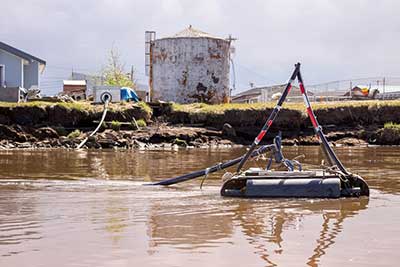
Our group walked around the landfill, looking for potential locations where we would perform testing the next day. I filmed Edda and Jacqueline as they surveyed the area for suitable sampling sites and was bombarded by the famously huge and countless Alaskan mosquitoes. After our assessment, we boated back to town to prepare for sampling the next day.
After checking in at the school, (Kotlik doesn’t have a hotel so I slept in the third grade classroom) I went to the community grocery store for some food. I was surprised by the high prices for simple things like bottled water and produce. Jacqueline explained to me that everything is expensive in rural Alaskan villages because they have to ship everything in on small passenger planes like the one we arrived in. Community members rely on subsistence fishing, hunting and berry foraging for much of their diet.
I spent my evening wandering around the community boardwalk and chatting with the residents. I was inspired by how friendly and welcoming everyone was towards me. Outside visitors are rare in Kotlik and I’m sure I stood out like a sore thumb, but the people I met treated me like family. Almost everyone said hello to me and many stopped me to have a conversation about what I was doing there and where I came from. They were excited to know that someone was trying to help them with the landfill/drinking water situation and to meet someone from out of town. The genuine, welcoming nature was refreshing to me as someone who spends most of his time in urban areas where people don’t even look at you as you pass on the street. I have never felt so welcome among strangers.
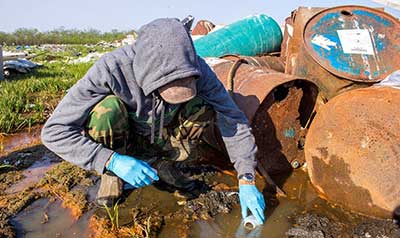
We woke up early the next day and headed back to the landfill for the sampling. The town was quiet and the river was foggy and still. I set up my camera and filmed as Edda showed Victor and the other landfill staff how to collect samples and test for PH, dissolved oxygen and turbidity. They were very attentive and eager to learn the proper techniques. They made sure to do everything right. This wasn’t just a job to them, they were learning how to keep their community safe and healthy. Once the landfill sampling was complete, we took the boat out to the drinking water intake pump. It is attached to a triangular buoy just outside the community and really isn’t very far from the landfill. Edda explained how to sample the water in the river and emphasized the importance of consistency on subsequent samplings. The staff listened and watched closely as she went through the procedure.
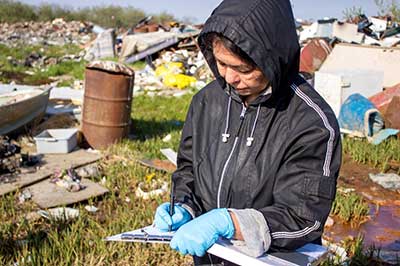
Once we had finished the sampling and were back at the office, Victor explained that a village elder had recently passed away and encouraged us to attend the ceremonial dance that evening. Eager to learn more about the culture, we went to the community center to observe the ceremony. A line of men sat in the back and sang repetitive chants while playing large shallow drums and a few women came to the front and started performing rhythmic dances in unison. As the evening progressed, more and more dancers would come forward and the male dancers would kneel in front and perform similar movements with feathered objects in their hands. Dancers would come and go between songs and the whole experience was very fun and informal. The dancers and crowd would occasionally bark and tease each other when the energy was high. Compared to the somber funeral services I am used to, this was a very joyful and lighthearted community gathering.
The next day, we tied up a few loose ends and packed up the samples for our flight back to Anchorage. Our final task was to hold a community meeting to discuss the landfill situation. A couple dozen people showed up for the meeting and my colleagues explained the importance of proper disposal practices at the landfill. Jacqueline told them to stop waiting for the government to help them and to work hard toward helping themselves by volunteering and looking for opportunities for change. As a fellow Yupik, she gave them a bit of tough love and stern encouragement that was very genuine and caring.
After saying our goodbyes and taking off in another small plane, I looked down at this small community on the river with a new perspective. Like many rural Alaskan villages, they face challenges. The people who live there, however, are resilient and some of the most kind, welcoming and genuine people I have ever met. Despite the challenges of living in an isolated village in rural Alaska, I believe their lively culture, humble way of life and strong sense of community is worth preserving.
Feature photo: Kolik’s water treatment plant, storage tank and piping. The pipes for water and wastewater are above ground, due to permafrost below. However, the permafrost is melting, causing challenges to the integrity of the pipes, and the connections of the pipes to the houses. Photo by Dustin Love.
Printed in Rural Matters, spring 2018
